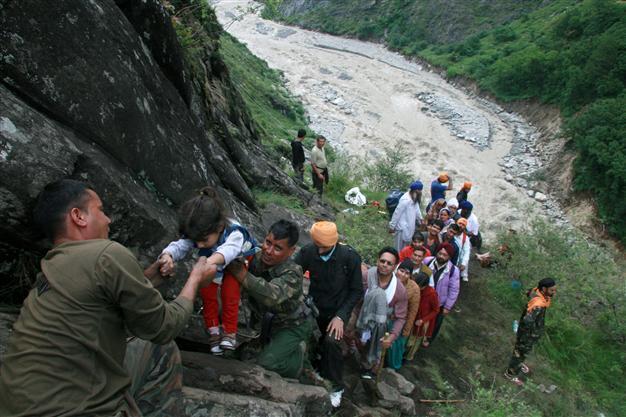India monsoon floods leave 138 dead
DEHRADUN, India - Agence France-Presse

Indian army officials help travellers and villagers up a steep slope after they were stranded by the rising floodwaters of the River Alaknanda near Govindghat, Chamoli District in the northern Indian state of Uttarakhand on June 18, 2013.AFP Photo
Military helicopters dropped emergency supplies Wednesday to thousands of tourists and pilgrims stranded by flash floods that tore through towns and temples in northern India, killing at least 138 people, officials said.
Thousands of people have already been evacuated after floods and landslides caused by early monsoon rains forged a path of devastation through two tourist states in the Himalayas, officials said.
"As of now we know that over 65,000 people are stranded," Home Minister Sushil Kumar Shinde told reporters in New Delhi.
"We are committed to rescuing everyone now that the rains have stopped," the minister said, adding that the army has evacuated 5,000 people cut off by the downpour.
Torrential rains at least three times as heavy as usual have hit the state of Uttarakhand, often called the "Land of the Gods," whose Hindu shrines and temples built high in the mountains attract many pilgrims.
Houses, multi-storied buildings, cars, bridges as well as roads have been swept away or badly damaged after rivers burst their banks, forcing authorities to deploy helicopters to evacuate people and drop essential food supplies.
Indian Prime Minister Manmohan Singh and president of the country's ruling Congress party, Sonia Gandhi, will later Wednesday fly over the disaster area to survey the extent of the damage.
"At least 110 people have died. The state government and the army are trying to rescue thousands of tourists who are stranded near the submerged valleys and Hindu shrines," said Yashpal Arya, the disaster relief minister of Uttarakhand.
Arya said portions of a well-known Hindu temple have been washed away, leaving about 10,000 pilgrims stranded.
"The Kedarnath temple is submerged in mud and slush. We just hope that it does not collapse," Arya told AFP.
Authorities fear the death toll could rise dramatically, with emergency workers still unable to reach villages cut off by the floods and landslides, five days after the rains hit on Saturday.
"We have been informed that several bodies are lying in the debris of damaged houses. Rescue operations will (now) pick up momentum as rains have stopped," said local revenue official S.K. Rautela.
Some 21 bridges have collapsed in the state, blocking access to villages, said Uttarakhand chief secretary Subash Kumar.
Local officials said 40 relief camps have been set up to provide food, water and other aid to locals and tourists. Air force helicopters from different parts of the state were taking many of those rescued to the camps, with a control centre set up in the holy town of Badrinath.
A military statement on Tuesday said five air bases in northern India had been activated to speed up operations.
In neighbouring Himachal Pradesh state, flash floods destroyed more than 500 houses and government buildings and at least 10 people were killed in landslides.
The monsoon, which India's farming sector depends on, covers the subcontinent from June to September, usually bringing some flooding. But the heavy rains arrived early this year, catching many by surprise and exposing the country's lack of preparedness.
Nilabja Ghosh, an economist working on climate change and agricultural methods in Uttarakhand, said the weather office had not issued any early warnings about the heavy rains.
"If the weather office had issued an early warning then authorities would have had the time to restrict tourist movement and shift residents to safer zones," said Ghosh who works at the Institute of Economic Growth in New Delhi.
"Temples, houses and bridges cannot be protected during flash floods but lives can be saved if early warnings are put in place."
